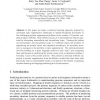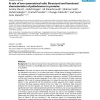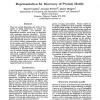20 search results - page 3 / 4 » Bayesian Segmentation of Protein Secondary Structure |
ISMIS
2005
Springer
13 years 10 months ago
2005
Springer
In this paper, we adapt a statistical learning approach, inspired by automated topic segmentation techniques in speech-recognized documents to the challenging protein segmentation ...
BMCBI
2004
13 years 5 months ago
2004
Background: Because loops connect regular secondary structures, analysis of the former depends directly on the definition of the latter. The numerous assignment methods, however, ...
JCB
2006
13 years 5 months ago
2006
Protein fold recognition is an important step towards understanding protein three-dimensional structures and their functions. A conditional graphical model, i.e., segmentation con...
BMCBI
2008
13 years 5 months ago
2008
Background: It has been previously shown that palindromic sequences are frequently observed in proteins. However, our knowledge about their evolutionary origin and their possible ...
ISMB
1993
13 years 6 months ago
1993
There are several dimensions and levels of complexity in which information on protein motifs may be available. For example, onedimensional sequence motifs may be associated with s...



